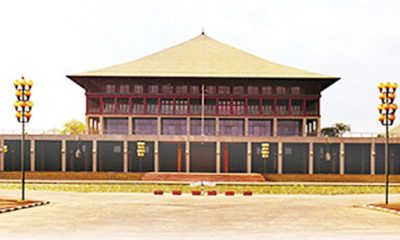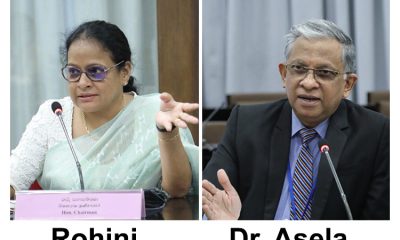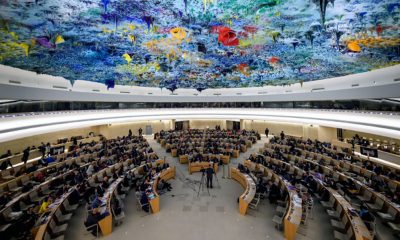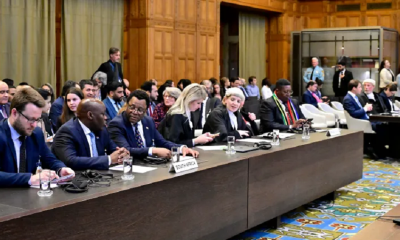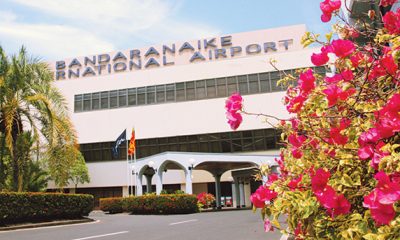Features
From a Sri Lankan : A Letter to the West
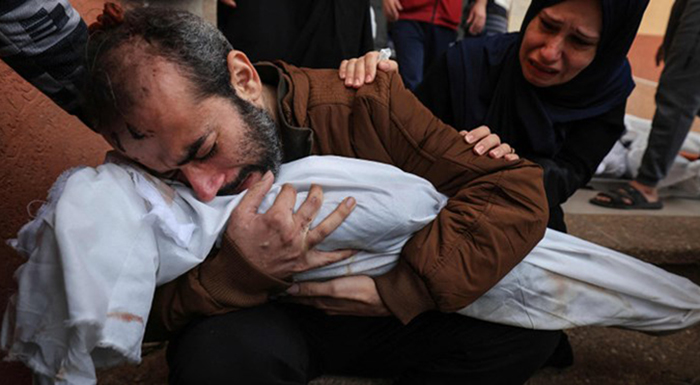
As the International Court of Justice prepares to deliver its verdict on South Africa’s case against Israel, this is an opportune moment to reflect on what it means for the West, the Global South, and international law and human rights.
The news from Gaza is pretty grim, and it is getting grimmer by the day. Nearly 24,000 civilians have been killed by Israeli forces since the war began on October 7, and they are dying at the rate of 250 a day. Oxfam has reported that the daily death toll of Palestinians exceeds that of any other major conflict in the 21st century.
Human Rights Watch says that the people of Gaza are being targeted, abused, and killed “at a scale unprecedented in the recent history of Israel and Palestine.” The Secretary General of Amnesty International observes that there is “no end in sight to the mass human suffering, devastation, and destruction we are witnessing on an hourly basis.”
Euro-Med Monitor reports that at least 14 Palestinians are dying by the hour. Most of them, two-thirds to be specific, are women and children. The Executive Director of UN Women points out that two mothers are killed every hour and seven women every two hours. For a region as small as Gaza, this is a staggering figure.
The statistics belie the horror of what they go through every day: with no access to water and medication, 180 women give birth every day under the most appalling conditions. The newborn face an uncertain future, riddled with death and violence.
Journalists and artists are also facing the brunt of the attacks. The Committee to Protect Journalists calls the current war the “deadliest period for journalists” since the organisation began collecting data in 1992.
The numbers are harrowing: 82 journalists have been killed so far, including 75 Palestinian and four Israeli. 25 have been arrested, and scores of others have been in some way and form assaulted, threatened, and censored.
Artists, including poets and writers, have become victims too. Israeli forces have killed at least 13 writers and poets since the war began last October. One of them, Heba Abu Nada, wrote the following post on Facebook on October 8.
“Our pages are consolation houses, mourning tents, obituaries, we go from page to page as if we are walking in a crowded, open funerals. Oh God, how heavy are these days!”
Twelve days later, she was killed by an Israeli airstrike.
These stories form a tapestry of horror and violence in Gaza and in Palestine. Overnight, ordinary civilians have been thrown into a war they did not call for.
They are being pummelled, flattened, erased out of existence, systematically exterminated, like vermin and outcasts. They are being dehumanised.
In this context, it’s everybody’s business to care. An entire people are being wiped off the face of the earth. The world cannot wait and watch.
And yet, one half of the world is doing exactly that. In response to South Africa’s case against Israel, one world leader after another is slowly, shamefacedly, getting up, holding lavish press conferences in which they say, in so many words, that what the Israeli government is committing is not a genocide.
The Canadian Prime Minister states that his government does not support the “premise” of South Africa’s case. He denies that there has been a genocide in Gaza.
Canada is not a stranger to claims of genocide. In 2021 reports surfaced of more than a hundred residential schools that had been set up to brutalise indigenous children. The Canadian Museum for Human Rights calls these institutions “part of a broader process of colonialism and genocide.” The schools were little better than concentration camps; one report highlights a death toll of more than 3,200.
Germany, too, has stated it will support Israel. The government claims that Hamas intends on destroying Israel and justifies its support of the Israeli government on the grounds that South Africa’s case amounts to “political instrumentalization.”
In response, the Namibian government has condemned Germany, and reminded the German government of the atrocities it committed against two indigenous communities, the Hereros and the Namas, between 1904 and 1908.
Germany’s campaign led to the deaths of almost a hundred thousand indigenous people. This is recognised today as the 20th century’s first case of genocide. In 1985 the United Nations officially classified it as such. In 2004 the German government issued an apology. But it refused to compensate the families of the victims.
As for the United States, President Joe Biden’s statement marking 100 days of the war makes no mention of Palestinian civilians. Leaders of such countries seem to have their notions of who constitutes people and who do not. For their governments, the people of Gaza do not meet the criteria, and hence can be disregarded.
In a way, I suppose these developments are interlinked. Hitler’s Final Solution had its antecedents in the West’s campaigns against indigenous communities. Europe’s wars of conquest and Washington’s forever wars share much in this regard.
As Alex Ross has noted in a perceptive piece in the New Yorker, American racism, specifically its campaigns against American Indians, influenced Hitler’s views on race.
Not that they have ever found this reason enough to atone for what they did. As John Wayne put it bluntly, “I don’t feel we did wrong in taking this great country away from them… There were great numbers of people who needed new land and the Indians were selfishly trying to keep it for themselves.”
It is hence not ironic that the same Western countries that sanctioned or looked the other when Hitler embarked on his genocidal campaigns should do so today, as tens of thousands of Palestinians find themselves on the brink of extinction.
What is ironic, however, is how these countries are shielding Israel from claims of genocide on the basis that Israel is at the receiving end of a genocide itself.
They frequently cite the October 7 attack, forgetting that the Israeli government’s response to those attacks has been anything but proportionate, and forgetting the many racist if hateful remarks that the most right-wing governments Israel has elected in its entire history has made, and continues to make, about the people of Gaza.
These countries have also forgotten the hundreds of thousands of Jewish voices who have risen against their own government. Some of these voices include relatives of the hostages captured by Hamas themselves. They say they don’t want this war to continue. But their own government, busy tweeting one ridiculous claim after another against South Africa, the ICJ, and the UN, seems not to have heard their call.
To be fair, not every Western country has made itself complicit in this genocide. Spain and Norway have voiced concerns. Long before the current conflict, the Mayor of Barcelona suspended ties with Jerusalem, citing its subjugation of Palestinians in Gaza.
And while governments have shamefully sided with Israel, civil society organisations, human rights activists, writers, poets, actors, directors, and academics have sided with Palestine. Establishment liberals have either gone quiet or chosen to focus on Hamas’s October 7 attack – an attack that warrants criticism. But the most unexpected figures from places like Hollywood have condemned the atrocities of the Israeli forces.
As an American friend put it the other day, when Tywin Lannister (Charles Dance) says you are committing genocide, perhaps you need to rethink your stance.
Nevertheless, the rift between our part of the world and theirs remain. This has several important ramifications. Europe and the United States, with Canada thrown in for good measure, have effectively abandoned what little moral clout they have. Their moral compass does not hold. For that matter, neither do they.
In just 100 days, the West has shown the world just how selectively human rights and all those other values it still thinks it holds dear can be applied.
When Russia invaded Ukraine, and hundreds of Ukrainians fled their homes, the media was awash with journalists crying over their plight. One correspondent thought it emotional “to see Europeans with blue eyes and blond hair being killed every day.”
Some victims, it seems, are more worthy than others. Palestinians, clearly, are not.
The West frequently speaks of a rules-based order and the equality of nations. These were values we thought would hold for all situations, for all countries, for all people.
That, however, has not been the case. There has been a disproportionate response to the tragedy unfolding in Gaza, and most countries in the Global North have been content in taking the side of those committing the atrocities.
The West refuses to hear the hundreds of thousands of millions of its own citizens who are speaking up for Palestine, and for Palestinian lives.
It refuses to listen to the hundreds of thousands of Jewish voices that are critical of Israeli forces and what they are doing in Gaza.It refuses to acknowledge the growing tide of global opinion against Israeli atrocities.
What does this mean? It means, simply, that the West has absconded from the moral high ground on which it thought it once stood. In doing so, it has given half the world a reason to come together, to gather around in solidarity.This is a definitive historical moment. As each day passes, the West’s tone-deafness makes it clear who is on the right side of history, and who is on the wrong.
Features
The heart-friendly health minister

by Dr Gotabhya Ranasinghe
Senior Consultant Cardiologist
National Hospital Sri Lanka
When we sought a meeting with Hon Dr. Ramesh Pathirana, Minister of Health, he graciously cleared his busy schedule to accommodate us. Renowned for his attentive listening and deep understanding, Minister Pathirana is dedicated to advancing the health sector. His openness and transparency exemplify the qualities of an exemplary politician and minister.
Dr. Palitha Mahipala, the current Health Secretary, demonstrates both commendable enthusiasm and unwavering support. This combination of attributes makes him a highly compatible colleague for the esteemed Minister of Health.
Our discussion centered on a project that has been in the works for the past 30 years, one that no other minister had managed to advance.
Minister Pathirana, however, recognized the project’s significance and its potential to revolutionize care for heart patients.
The project involves the construction of a state-of-the-art facility at the premises of the National Hospital Colombo. The project’s location within the premises of the National Hospital underscores its importance and relevance to the healthcare infrastructure of the nation.
This facility will include a cardiology building and a tertiary care center, equipped with the latest technology to handle and treat all types of heart-related conditions and surgeries.
Securing funding was a major milestone for this initiative. Minister Pathirana successfully obtained approval for a $40 billion loan from the Asian Development Bank. With the funding in place, the foundation stone is scheduled to be laid in September this year, and construction will begin in January 2025.
This project guarantees a consistent and uninterrupted supply of stents and related medications for heart patients. As a result, patients will have timely access to essential medical supplies during their treatment and recovery. By securing these critical resources, the project aims to enhance patient outcomes, minimize treatment delays, and maintain the highest standards of cardiac care.
Upon its fruition, this monumental building will serve as a beacon of hope and healing, symbolizing the unwavering dedication to improving patient outcomes and fostering a healthier society.We anticipate a future marked by significant progress and positive outcomes in Sri Lanka’s cardiovascular treatment landscape within the foreseeable timeframe.
Features
A LOVING TRIBUTE TO JESUIT FR. ALOYSIUS PIERIS ON HIS 90th BIRTHDAY

by Fr. Emmanuel Fernando, OMI
Jesuit Fr. Aloysius Pieris (affectionately called Fr. Aloy) celebrated his 90th birthday on April 9, 2024 and I, as the editor of our Oblate Journal, THE MISSIONARY OBLATE had gone to press by that time. Immediately I decided to publish an article, appreciating the untiring selfless services he continues to offer for inter-Faith dialogue, the renewal of the Catholic Church, his concern for the poor and the suffering Sri Lankan masses and to me, the present writer.
It was in 1988, when I was appointed Director of the Oblate Scholastics at Ampitiya by the then Oblate Provincial Fr. Anselm Silva, that I came to know Fr. Aloy more closely. Knowing well his expertise in matters spiritual, theological, Indological and pastoral, and with the collaborative spirit of my companion-formators, our Oblate Scholastics were sent to Tulana, the Research and Encounter Centre, Kelaniya, of which he is the Founder-Director, for ‘exposure-programmes’ on matters spiritual, biblical, theological and pastoral. Some of these dimensions according to my view and that of my companion-formators, were not available at the National Seminary, Ampitiya.
Ever since that time, our Oblate formators/ accompaniers at the Oblate Scholasticate, Ampitiya , have continued to send our Oblate Scholastics to Tulana Centre for deepening their insights and convictions regarding matters needed to serve the people in today’s context. Fr. Aloy also had tried very enthusiastically with the Oblate team headed by Frs. Oswald Firth and Clement Waidyasekara to begin a Theologate, directed by the Religious Congregations in Sri Lanka, for the contextual formation/ accompaniment of their members. It should very well be a desired goal of the Leaders / Provincials of the Religious Congregations.
Besides being a formator/accompanier at the Oblate Scholasticate, I was entrusted also with the task of editing and publishing our Oblate journal, ‘The Missionary Oblate’. To maintain the quality of the journal I continue to depend on Fr. Aloy for his thought-provoking and stimulating articles on Biblical Spirituality, Biblical Theology and Ecclesiology. I am very grateful to him for his generous assistance. Of late, his writings on renewal of the Church, initiated by Pope St. John XX111 and continued by Pope Francis through the Synodal path, published in our Oblate journal, enable our readers to focus their attention also on the needed renewal in the Catholic Church in Sri Lanka. Fr. Aloy appreciated very much the Synodal path adopted by the Jesuit Pope Francis for the renewal of the Church, rooted very much on prayerful discernment. In my Religious and presbyteral life, Fr.Aloy continues to be my spiritual animator / guide and ongoing formator / acccompanier.
Fr. Aloysius Pieris, BA Hons (Lond), LPh (SHC, India), STL (PFT, Naples), PhD (SLU/VC), ThD (Tilburg), D.Ltt (KU), has been one of the eminent Asian theologians well recognized internationally and one who has lectured and held visiting chairs in many universities both in the West and in the East. Many members of Religious Congregations from Asian countries have benefited from his lectures and guidance in the East Asian Pastoral Institute (EAPI) in Manila, Philippines. He had been a Theologian consulted by the Federation of Asian Bishops’ Conferences for many years. During his professorship at the Gregorian University in Rome, he was called to be a member of a special group of advisers on other religions consulted by Pope Paul VI.
Fr. Aloy is the author of more than 30 books and well over 500 Research Papers. Some of his books and articles have been translated and published in several countries. Among those books, one can find the following: 1) The Genesis of an Asian Theology of Liberation (An Autobiographical Excursus on the Art of Theologising in Asia, 2) An Asian Theology of Liberation, 3) Providential Timeliness of Vatican 11 (a long-overdue halt to a scandalous millennium, 4) Give Vatican 11 a chance, 5) Leadership in the Church, 6) Relishing our faith in working for justice (Themes for study and discussion), 7) A Message meant mainly, not exclusively for Jesuits (Background information necessary for helping Francis renew the Church), 8) Lent in Lanka (Reflections and Resolutions, 9) Love meets wisdom (A Christian Experience of Buddhism, 10) Fire and Water 11) God’s Reign for God’s poor, 12) Our Unhiddden Agenda (How we Jesuits work, pray and form our men). He is also the Editor of two journals, Vagdevi, Journal of Religious Reflection and Dialogue, New Series.
Fr. Aloy has a BA in Pali and Sanskrit from the University of London and a Ph.D in Buddhist Philosophy from the University of Sri Lankan, Vidyodaya Campus. On Nov. 23, 2019, he was awarded the prestigious honorary Doctorate of Literature (D.Litt) by the Chancellor of the University of Kelaniya, the Most Venerable Welamitiyawe Dharmakirthi Sri Kusala Dhamma Thera.
Fr. Aloy continues to be a promoter of Gospel values and virtues. Justice as a constitutive dimension of love and social concern for the downtrodden masses are very much noted in his life and work. He had very much appreciated the commitment of the late Fr. Joseph (Joe) Fernando, the National Director of the Social and Economic Centre (SEDEC) for the poor.
In Sri Lanka, a few religious Congregations – the Good Shepherd Sisters, the Christian Brothers, the Marist Brothers and the Oblates – have invited him to animate their members especially during their Provincial Congresses, Chapters and International Conferences. The mainline Christian Churches also have sought his advice and followed his seminars. I, for one, regret very much, that the Sri Lankan authorities of the Catholic Church –today’s Hierarchy—- have not sought Fr.
Aloy’s expertise for the renewal of the Catholic Church in Sri Lanka and thus have not benefited from the immense store of wisdom and insight that he can offer to our local Church while the Sri Lankan bishops who governed the Catholic church in the immediate aftermath of the Second Vatican Council (Edmund Fernando OMI, Anthony de Saram, Leo Nanayakkara OSB, Frank Marcus Fernando, Paul Perera,) visited him and consulted him on many matters. Among the Tamil Bishops, Bishop Rayappu Joseph was keeping close contact with him and Bishop J. Deogupillai hosted him and his team visiting him after the horrible Black July massacre of Tamils.
Features
A fairy tale, success or debacle

Sri Lanka-Singapore Free Trade Agreement
By Gomi Senadhira
senadhiragomi@gmail.com
“You might tell fairy tales, but the progress of a country cannot be achieved through such narratives. A country cannot be developed by making false promises. The country moved backward because of the electoral promises made by political parties throughout time. We have witnessed that the ultimate result of this is the country becoming bankrupt. Unfortunately, many segments of the population have not come to realize this yet.” – President Ranil Wickremesinghe, 2024 Budget speech
Any Sri Lankan would agree with the above words of President Wickremesinghe on the false promises our politicians and officials make and the fairy tales they narrate which bankrupted this country. So, to understand this, let’s look at one such fairy tale with lots of false promises; Ranil Wickremesinghe’s greatest achievement in the area of international trade and investment promotion during the Yahapalana period, Sri Lanka-Singapore Free Trade Agreement (SLSFTA).
It is appropriate and timely to do it now as Finance Minister Wickremesinghe has just presented to parliament a bill on the National Policy on Economic Transformation which includes the establishment of an Office for International Trade and the Sri Lanka Institute of Economics and International Trade.
Was SLSFTA a “Cleverly negotiated Free Trade Agreement” as stated by the (former) Minister of Development Strategies and International Trade Malik Samarawickrama during the Parliamentary Debate on the SLSFTA in July 2018, or a colossal blunder covered up with lies, false promises, and fairy tales? After SLSFTA was signed there were a number of fairy tales published on this agreement by the Ministry of Development Strategies and International, Institute of Policy Studies, and others.
However, for this article, I would like to limit my comments to the speech by Minister Samarawickrama during the Parliamentary Debate, and the two most important areas in the agreement which were covered up with lies, fairy tales, and false promises, namely: revenue loss for Sri Lanka and Investment from Singapore. On the other important area, “Waste products dumping” I do not want to comment here as I have written extensively on the issue.
1. The revenue loss
During the Parliamentary Debate in July 2018, Minister Samarawickrama stated “…. let me reiterate that this FTA with Singapore has been very cleverly negotiated by us…. The liberalisation programme under this FTA has been carefully designed to have the least impact on domestic industry and revenue collection. We have included all revenue sensitive items in the negative list of items which will not be subject to removal of tariff. Therefore, 97.8% revenue from Customs duty is protected. Our tariff liberalisation will take place over a period of 12-15 years! In fact, the revenue earned through tariffs on goods imported from Singapore last year was Rs. 35 billion.
The revenue loss for over the next 15 years due to the FTA is only Rs. 733 million– which when annualised, on average, is just Rs. 51 million. That is just 0.14% per year! So anyone who claims the Singapore FTA causes revenue loss to the Government cannot do basic arithmetic! Mr. Speaker, in conclusion, I call on my fellow members of this House – don’t mislead the public with baseless criticism that is not grounded in facts. Don’t look at petty politics and use these issues for your own political survival.”
I was surprised to read the minister’s speech because an article published in January 2018 in “The Straits Times“, based on information released by the Singaporean Negotiators stated, “…. With the FTA, tariff savings for Singapore exports are estimated to hit $10 million annually“.
As the annual tariff savings (that is the revenue loss for Sri Lanka) calculated by the Singaporean Negotiators, Singaporean $ 10 million (Sri Lankan rupees 1,200 million in 2018) was way above the rupees’ 733 million revenue loss for 15 years estimated by the Sri Lankan negotiators, it was clear to any observer that one of the parties to the agreement had not done the basic arithmetic!
Six years later, according to a report published by “The Morning” newspaper, speaking at the Committee on Public Finance (COPF) on 7th May 2024, Mr Samarawickrama’s chief trade negotiator K.J. Weerasinghehad had admitted “…. that forecasted revenue loss for the Government of Sri Lanka through the Singapore FTA is Rs. 450 million in 2023 and Rs. 1.3 billion in 2024.”
If these numbers are correct, as tariff liberalisation under the SLSFTA has just started, we will pass Rs 2 billion very soon. Then, the question is how Sri Lanka’s trade negotiators made such a colossal blunder. Didn’t they do their basic arithmetic? If they didn’t know how to do basic arithmetic they should have at least done their basic readings. For example, the headline of the article published in The Straits Times in January 2018 was “Singapore, Sri Lanka sign FTA, annual savings of $10m expected”.
Anyway, as Sri Lanka’s chief negotiator reiterated at the COPF meeting that “…. since 99% of the tariffs in Singapore have zero rates of duty, Sri Lanka has agreed on 80% tariff liberalisation over a period of 15 years while expecting Singapore investments to address the imbalance in trade,” let’s turn towards investment.
Investment from Singapore
In July 2018, speaking during the Parliamentary Debate on the FTA this is what Minister Malik Samarawickrama stated on investment from Singapore, “Already, thanks to this FTA, in just the past two-and-a-half months since the agreement came into effect we have received a proposal from Singapore for investment amounting to $ 14.8 billion in an oil refinery for export of petroleum products. In addition, we have proposals for a steel manufacturing plant for exports ($ 1 billion investment), flour milling plant ($ 50 million), sugar refinery ($ 200 million). This adds up to more than $ 16.05 billion in the pipeline on these projects alone.
And all of these projects will create thousands of more jobs for our people. In principle approval has already been granted by the BOI and the investors are awaiting the release of land the environmental approvals to commence the project.
I request the Opposition and those with vested interests to change their narrow-minded thinking and join us to develop our country. We must always look at what is best for the whole community, not just the few who may oppose. We owe it to our people to courageously take decisions that will change their lives for the better.”
According to the media report I quoted earlier, speaking at the Committee on Public Finance (COPF) Chief Negotiator Weerasinghe has admitted that Sri Lanka was not happy with overall Singapore investments that have come in the past few years in return for the trade liberalisation under the Singapore-Sri Lanka Free Trade Agreement. He has added that between 2021 and 2023 the total investment from Singapore had been around $162 million!
What happened to those projects worth $16 billion negotiated, thanks to the SLSFTA, in just the two-and-a-half months after the agreement came into effect and approved by the BOI? I do not know about the steel manufacturing plant for exports ($ 1 billion investment), flour milling plant ($ 50 million) and sugar refinery ($ 200 million).
However, story of the multibillion-dollar investment in the Petroleum Refinery unfolded in a manner that would qualify it as the best fairy tale with false promises presented by our politicians and the officials, prior to 2019 elections.
Though many Sri Lankans got to know, through the media which repeatedly highlighted a plethora of issues surrounding the project and the questionable credentials of the Singaporean investor, the construction work on the Mirrijiwela Oil Refinery along with the cement factory began on the24th of March 2019 with a bang and Minister Ranil Wickremesinghe and his ministers along with the foreign and local dignitaries laid the foundation stones.
That was few months before the 2019 Presidential elections. Inaugurating the construction work Prime Minister Ranil Wickremesinghe said the projects will create thousands of job opportunities in the area and surrounding districts.
The oil refinery, which was to be built over 200 acres of land, with the capacity to refine 200,000 barrels of crude oil per day, was to generate US$7 billion of exports and create 1,500 direct and 3,000 indirect jobs. The construction of the refinery was to be completed in 44 months. Four years later, in August 2023 the Cabinet of Ministers approved the proposal presented by President Ranil Wickremesinghe to cancel the agreement with the investors of the refinery as the project has not been implemented! Can they explain to the country how much money was wasted to produce that fairy tale?
It is obvious that the President, ministers, and officials had made huge blunders and had deliberately misled the public and the parliament on the revenue loss and potential investment from SLSFTA with fairy tales and false promises.
As the president himself said, a country cannot be developed by making false promises or with fairy tales and these false promises and fairy tales had bankrupted the country. “Unfortunately, many segments of the population have not come to realize this yet”.
(The writer, a specialist and an activist on trade and development issues . )


